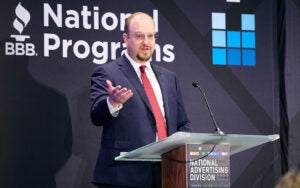Friday marks the end of week one of the antitrust remedies trial between Google and the Department of Justice (DOJ). The trial will determine the punishments and required changes for Google following the court’s decision in April that it operates an illegal monopoly in the publisher ad exchange and ad server markets for open web display advertising.
Both sides spent the first half of the week debating the nuances of online advertising before Judge Leonie Brinkema, who is deciding the case for the US District Court of Eastern Virginia. But much of that discussion was waved off by Brinkema as an essentially useless rehash of what was discussed at trial last September.
Instead, Brinkema said, bring me Googlers and experts who can speak to the feasibility of divesting the Google ad exchange, called AdX, and the publisher ad server, which is DFP.
On Thursday, the court heard from Google’s Tim Craycroft, who, as VP and GM of Google Advertising, runs the ad exchange and ad server products in question. And the particular issues that define the case for Judge Brinkema have begun to materialize.
Can a divestiture be done?
One of the key disputes throughout the week, for Google’s lawyers, at least, has been the claim that a divestiture of AdX and DFP is essentially impossible. Those products don’t even exist anymore and haven’t for many years. They’ve been folded into Google Ad Manager.
Craycroft did help the DOJ’s case along on Thursday by revealing that Google has considered different permutations of divestiture of the sell-side ad tech business. The DOJ forced onto the record the existence of Project Sunday, which was an evaluation of a potential spin-off of AdX and DFP, and a follow-up called Project Monday that evaluated a complete AdX shutdown. Google’s own evaluation did determine that a divestiture is feasible. Although, Google’s internal notes indicate a years-long timeline – like four years to divest DFP, with half of that time to prep for the sale and the other half as a migration of their code after a deal.
On the other hand, the DOJ’s industry witnesses haven’t been super helpful on this front.
For instance, James Avery of Kevel said his company would consider an acquisition of either or both AdX and DFP. However, he added, he didn’t think the two made much sense to sell separately. To maintain a free ad server base for long-tail DFP publishers, the product would need the revenue and margin of the ad exchange business.
Jay Friedman, strategic advisor and formerly CEO of Goodway Group, said he didn’t think AdX was worth anything and probably should just be shut down.
Luke Lambert, a senior leader at Omnicom, outlined an excruciating “pain of divestiture” if AdX were sold off by Google. “I already know people who cry to me, overwhelmed with work,” he said. “Even media buying teams at agencies don’t know the difficulty of being a programmatic trader.”
Those are not helpful deviations from the government’s proposed remedies, which ask for a full divestiture of AdX and a possible divestiture of DFP within a few years.
War of the words
Another problem for the DOJ, and an advantage leveraged by Google, is the confusion of certain words in programmatic advertising and in this specific trial.
Quibbles about whether inventory is legitimate or illegitimate, direct or indirect, open or not open, can mean different things in industry parlance rather than colloquially how someone might use the word.
Google, for example, is pushing for programmatic guaranteed and private marketplace deals to be exempt from the court’s ruling, since the judge narrowly defined its monopolies in “open web display advertising.” Those types of deals are direct, more like how a brand might run a takeover of the ESPN homepage, per Google’s definition, although they might go through programmatic pipes and could be transacted via Prebid.
The term “open web display advertising” is itself a hangup in the case. Because it’s not a real category; it was crafted by the court for the purposes of this trial. The DOJ’s investment banking expert witness, Paul Crisci, had his reports and testimony called into question by Google as irrelevant because he based his data on a market spend report that evaluated media by “Display,” “CTV,” “Mobile in-app,” etc.
Probably the biggest point of confusion is “Final Auction Logic.”
You’ve never heard of it?
That makes sense. Again, it’s a term constructed by lawyers to describe the ad server code that makes the final call on which ad to pick. The DOJ wants this code to be open-sourced, so that when Google’s ad server makes that call, vendors, publishers and advertisers can understand why.
The theory sounds fine. But even people familiar with programmatic are flummoxed when pressed about Final Auction Logic as, like, a capitalized term.
The net result is a great deal of confusion, which favors Google, because the government will need a clear, feasible path to pulling off a divestiture and the other behavioral remedies it’s calling for, like with Final Auction Logic.
On the Brinkema
So where does the case stand after the first few days?
Only Judge Brinkema herself and her law clerks would have any real sense. However, her interjections in the court room and observing the process of the trial so far makes clear that the DOJ has some real convincing to do to win on its proposed remedies.
She halted the government’s economic expert witness, professor Robin Lee of Harvard University, to press on the potential repercussions for small publishers that currently use DFP for free. “Wouldn’t that fall primarily on [small businesses]?” she asked.
Or, she speculated, what if Google decides to abandon open web advertising, shifting budgets instead to its own properties? Wouldn’t the overall value of small, open web publishers diminish?
At another point, she interjected to again theorize that Google might, for instance, offer advertisers vouchers to further incentivize its own properties, rather than the new channels being opened up between third-party programmatic vendors, advertisers and publishers.
There is obvious short-term pain in the DOJ’s divestiture plan. For advertisers, as Lambert described in sad detail, as well as for publishers, hundreds of thousands of whom might all of a sudden face an ad server fee for the first time. Judge Brinkema has clearly adopted that baseline thinking and even thinks Google might turn the knife a bit by deliberately pulling back from open web advertising.
She didn’t say that would be an illegal action; she speculated on its likelihood.
The other issue is time.
If Judge Brinkema adopts the DOJ’s proposed remedies, the government is signed up for at least a decade’s worth of oversight, monitoring, legal back-and-forthing and all sorts of administrative duties that seem like no fun at all. The DOJ’s own timeline stretches out to 14 years, although it includes hypothetical actions.
Google’s counsel, in their opening remarks, noted that the company can commit to having its remedy proposal done within a year, with a bow on.
Nobody seems to want the case to drag on. Even the janitors and court officers were complaining after hours on Wednesday because the pallets of file boxes wheeled in that day by both sides had done perhaps irreparable damage, scuff-wise, to the courthouse floors.
“Oh, the trees we’ve sacrificed,” Judge Brinkema noted when she entered the courtroom.
Plus, as Google’s counsels are quick to note, the details of this case are mostly from five to 10 years ago. The court can make the rules of the race fair, the lawyers argued, without putting a symbolic ball and chain on Google’s ad tech moving forward.
Regardless of how Judge Brinkema decides, both sides will eventually make their final exit out the courthouse doors below a sweeping statue that depicts the blind justice with balanced scales, astride the massively printed quote: “Justice Delayed, Justice Denied.”
















